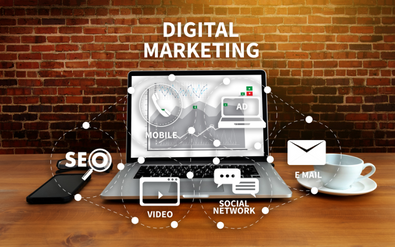Alejandro Perez | September 23, 2021
In today’s world, creating a strong digital marketing plan is essential to ensure the growth of your business. A solid digital marketing plan will pave the way to help your company generate leads and increase sales, but what does it entail and how can one stay on top of marketing trends?
The following is my step-by-step guide to structuring a sound digital marketing plan.
Situational Analysis
Getting a clear understanding of your company’s marketing situation starts with a situational analysis also known as SWOT. This framework will help you identify what your business does well, its qualities and weaknesses, opportunities for improvement, and any perceived or real threats to your company’s image or reputation. 
During this phase, it’s also important to perform a competitive analysis to get a better idea of who your competitors are and what they are doing well. When carrying out this research it’s important to ask yourself:
- Who are the direct competitors in your area?
- Who are the indirect competitors in your area?
- What services do they offer?
- How do these competitors utilize social media?
- What kind of content do they post?
- How are their audiences engaging with their business online?
Establishing Goals
Once your SWAT is completed, it’s time to create goals and lay out a strategic plan.
I’ve learned that setting SMART goals is a great way to ensure that your goals are achievable and realistic. Examples of SMART goals include:
- Increase web traffic by 15% during the 3rd quarter of 2021.
- Increase social media engagement by 10% during the month of September by posting more relevant content on LinkedIn and Instagram channels.
- Gain 250 new followers by the 4th quarter of 2021 by posting educational and relevant content our audience can interact with.
Defining your Marketing Strategy
Once your SMART goals are listed start defining your marketing strategy and what objectives you will take to carry them out. It’s also very important to remember to personalize every aspect of your strategy.
Important factors to keep in mind:
- Target Audience: Make sure you understand your target audience, their values, and what drives them to purchase. If you aren’t sure who your target audience is don’t skimp on creating a buyer persona.

- Value Proposition: In order to incorporate a clear value proposition, it’s important that you are very clear when describing what it entails and why your customer should choose your business and not your competition. It’s also necessary to keep this constant throughout all your digital channels.
- SEO: Search Engine Optimization is another important aspect of digital marketing. Simply put, optimizing your website’s SEO allows you to rank higher within Google’s search engine so you can generate more traffic to your website.
- Content Strategy: Creating a communication plan is essential for understanding how your business will create, distribute, and manage all of its content. It’s also important to look at your current digital marketing channels and evaluate which ones are getting the most engagement and producing an ROI. Additionally, knowing which social media platforms your target audience uses will help you figure out where to push your content.
- Content Calendars: Use a content calendar to lay out a structured content plan and think long-term.
Digital Strategies and Tactics to Increasing Digital Brand Awareness
Based on the specific objectives of your digital marketing plan, there are a variety of different marketing strategies you can utilize. 
Content Marketing – Content marketing is best utilized when you can provide free and valuable content that is relevant to your industry in order to reach larger audiences and build trust. B2B companies who engage in content marketing/blogging receive 67% more leads compared to those that don’t.
Establish Thought Leadership through content marketing – Publish content that shows your knowledge and expertise by sharing it on other authoritative and relevant sites, industry associations and journals, and online news websites. This adds credibility to your business and improves your brand reputation.
Social Media Marketing (SMM) – Depending on your business, Social SMM can be the most important aspect of your digital marketing plan. By utilizing different social platforms such as Instagram, Twitter, Facebook, and TikTok, you can create unique content that markets your product or service to your audience. However, it’s important that you know which platforms your target audience is using so you know where to focus your SMM efforts.
Email Marketing – Also known as “direct marketing” email marketing is a great way to individually market your product or service and build customer loyalty. This is a great way to send and update your customer’s information on discounts, promotions, new products, or services and even drive them back to your website or social media. When utilizing email marketing, this is a great opportunity to create a strong “call to action.”
Search Engine Optimization – The primary goal when it comes to running a website is to bring organic traffic to that website. However, it can be extremely difficult when there are hundreds or even thousands of other websites similar to yours. Thus, in order to improve your website’s search rankings, it’s important to incorporate SEO. A great way to start is by doing keyword research and finding popular words to incorporate on your site. Another great method of SEO is by utilizing White Hat SEO by creating high-quality information and guest posting on other websites and leaving a backlink to your site.
B2B and B2C Influencer Marketing – Influencer marketing is a great way to utilize highly recognized individuals and associate them with your brand. However, when researching influencers, it’s important to find influencers that have a similar target audience to yours. Not to mention, influencers can be very expensive so you should make sure they are within your budget.
On the other hand, B2B influencer marketing can be used a little differently.
How? A great way for B2B companies to use influencer marketing is by leveraging your existing/past customers to promote to other businesses. Utilizing the success stories of your existing and past customers can increase credibility and build trust when past clients explain the challenges they were facing prior to working with you.
Why?
- Existing & past customers can influence our target market.
- Businesses trust the opinion of others in the same space or industry.
Potential customers will value the reviews and experiences shared by our previous clients.
Measuring KPIs and Social Media Analytics
The last step in carrying out your digital marketing plan is to measure and track the results of your Key Performance Indicators. When doing this it is crucial that you measure the results among all of your media channels including social media so you can turn your data into valuable insights that will enable strategic decision-making. 
Some key insights to look out for include:
- Social Media Activity: Which content has been getting the most engagement? Which haven’t? Which posting times have received the best engagement? How many followers have I gained?
- Brand Assessment: What have people been saying about my brand on social media?
- Marketing Campaigns: Was the campaign effective? Did it accomplish what we wanted?
- Industry Trends: What are the new popular trends to look out for or act on
- Performance Benchmarking: How is my product or service doing against my competitors?
- Crisis Management: Are there any potential issues I can resolve before they get out of control?
- Audience Interest: Who is interested in my product/service? What are their demographics?
With these various insights, you now have the opportunity to adjust your digital marketing plan accordingly.





